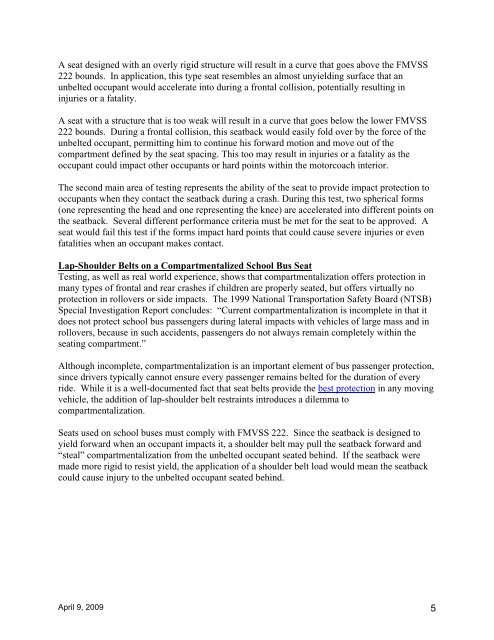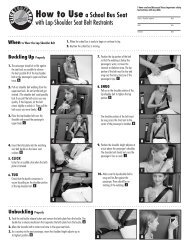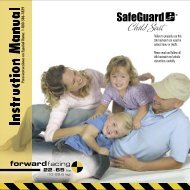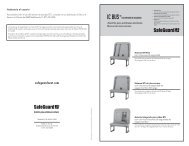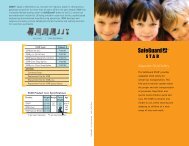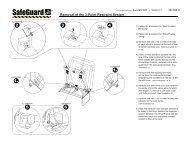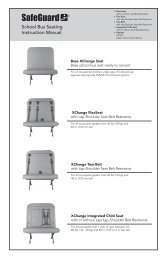Compartmentalization and the Motorcoach - SafeGuard
Compartmentalization and the Motorcoach - SafeGuard
Compartmentalization and the Motorcoach - SafeGuard
- No tags were found...
You also want an ePaper? Increase the reach of your titles
YUMPU automatically turns print PDFs into web optimized ePapers that Google loves.
A seat designed with an overly rigid structure will result in a curve that goes above <strong>the</strong> FMVSS222 bounds. In application, this type seat resembles an almost unyielding surface that anunbelted occupant would accelerate into during a frontal collision, potentially resulting ininjuries or a fatality.A seat with a structure that is too weak will result in a curve that goes below <strong>the</strong> lower FMVSS222 bounds. During a frontal collision, this seatback would easily fold over by <strong>the</strong> force of <strong>the</strong>unbelted occupant, permitting him to continue his forward motion <strong>and</strong> move out of <strong>the</strong>compartment defined by <strong>the</strong> seat spacing. This too may result in injuries or a fatality as <strong>the</strong>occupant could impact o<strong>the</strong>r occupants or hard points within <strong>the</strong> motorcoach interior.The second main area of testing represents <strong>the</strong> ability of <strong>the</strong> seat to provide impact protection tooccupants when <strong>the</strong>y contact <strong>the</strong> seatback during a crash. During this test, two spherical forms(one representing <strong>the</strong> head <strong>and</strong> one representing <strong>the</strong> knee) are accelerated into different points on<strong>the</strong> seatback. Several different performance criteria must be met for <strong>the</strong> seat to be approved. Aseat would fail this test if <strong>the</strong> forms impact hard points that could cause severe injuries or evenfatalities when an occupant makes contact.Lap-Shoulder Belts on a Compartmentalized School Bus SeatTesting, as well as real world experience, shows that compartmentalization offers protection inmany types of frontal <strong>and</strong> rear crashes if children are properly seated, but offers virtually noprotection in rollovers or side impacts. The 1999 National Transportation Safety Board (NTSB)Special Investigation Report concludes: “Current compartmentalization is incomplete in that itdoes not protect school bus passengers during lateral impacts with vehicles of large mass <strong>and</strong> inrollovers, because in such accidents, passengers do not always remain completely within <strong>the</strong>seating compartment.”Although incomplete, compartmentalization is an important element of bus passenger protection,since drivers typically cannot ensure every passenger remains belted for <strong>the</strong> duration of everyride. While it is a well-documented fact that seat belts provide <strong>the</strong> best protection in any movingvehicle, <strong>the</strong> addition of lap-shoulder belt restraints introduces a dilemma tocompartmentalization.Seats used on school buses must comply with FMVSS 222. Since <strong>the</strong> seatback is designed toyield forward when an occupant impacts it, a shoulder belt may pull <strong>the</strong> seatback forward <strong>and</strong>“steal” compartmentalization from <strong>the</strong> unbelted occupant seated behind. If <strong>the</strong> seatback weremade more rigid to resist yield, <strong>the</strong> application of a shoulder belt load would mean <strong>the</strong> seatbackcould cause injury to <strong>the</strong> unbelted occupant seated behind.April 9, 2009 5


